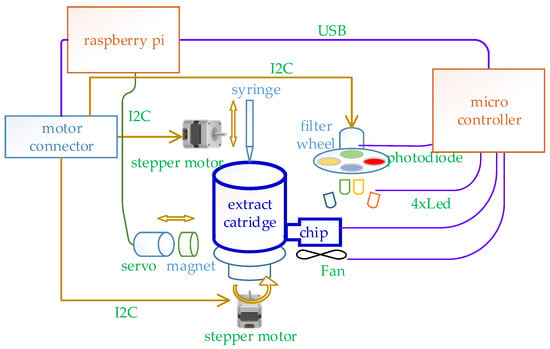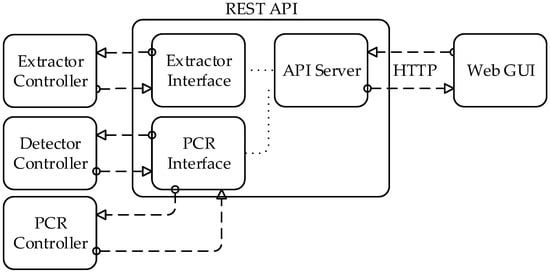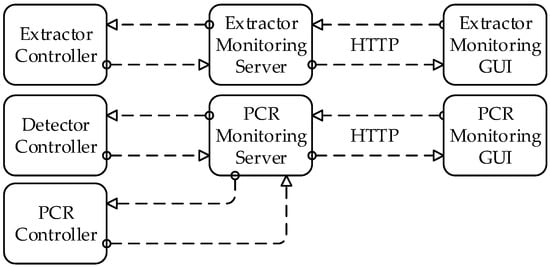Abstract
In this paper, we investigate an efficient structure for a point-of-care (POC) molecular diagnostic system based on the industrial Internet of things (IIoT). The target system can perform automated molecular diagnosis including DNA extraction, PCR amplification, and fluorescence detection. Samples and reagents are placed in a multi-room cartridge and loaded into the system. A rotating motor and a syringe motor control the cartridge to extract DNA from the sample. The extracted DNA is transferred to a polymerase chain reaction (PCR) chamber for DNA amplification and detection. The proposed system provides multiplexing of up to four colors. For POC molecular diagnostics, the World Health Organization demands features such as low volume, low cost, fast results, and a user-friendly interface. In this paper, we propose a system structure that can satisfy these requirements by using a PCR chip and open platform. A distributed structure is adopted for the convenience of maintenance, and a web-based GUI is adopted for the user’s convenience. We also investigated communication problems that may occur between system components. Using the proposed structure, the user can conveniently control from standard computing devices including a smartphone.
1. Introduction
The disease-related mortality rate is high because it is difficult to diagnose infectious diseases in environments with limited resources, such as in developing countries. In this environment, in order to reduce the mortality rate due to infectious diseases, it is necessary to improve the performance of various test methods and shorten the test time. For this reason, various diagnostic methods have been developed and point-of-care (POC) is being used [1].
There are several methods for diagnosing infectious diseases with POC. Among them, culturing viruses or serological diagnosis methods take a lot of time for obtaining, extracting, and analyzing samples, and the extraction process of the sample is also complicated. Therefore, molecular biological diagnosis methods are preferred [2].
The World Health Organization (WHO) proposed ASSURED (Affordable, Sensitive, Specific, User-friendly, Rapid and robust, Equipment-free, and Deliverable to end-users) as a performance evaluation index for POC devices [1]. In this paper, the proposed system used an open platform using disposable polymerase chain reaction (PCR) chips [3]. POC equipment consumes a lot of time and human resources for maintenance, and this can be saved by using an open platform. In addition, in the existing POC device software architectures, each function was controlled by one process. This causes difficulties to maintain and to operate the system and monitor the functions of the device at the same time. This paper introduces a distributed software architecture and a web-based user interface [4].
2. Materials and Methods
The molecular diagnosis process is functionally divided into a nucleic acid extraction, an amplification, and detection of nucleic acids. Figure 1 is the hardware system architecture of the proposed system that performs these functions.

Figure 1.
Function diagram and optics detector hardware system architecture.
In the system, the nucleic acid extraction unit operates based on a magnetic bead-based DNA extraction protocol and uses two stepper motors and one servo motor. Each of the two stepper motors selects a cartridge chamber or controls a syringe for moving reagents between chambers. The servo motor is used to hold the magnetic beads by bringing the magnet close to the chamber. The cartridge has several chambers where the samples, magnetic beads, and reagents used in the protocol are loaded.
By controlling three motors, DNA is extracted by performing the DNA extraction protocol: lysis, add beads, separation, wash, and elution. The extracted nucleic acid is moved to a PCR chip connected to the cartridge, and nucleic acid amplification and detection are performed.
The nucleic acid amplification and detection unit uses a PCR chip, a fan, a stepper motor, a photodiode, four LEDs, an excitation filter, and an emission filter. The PCR chip is equipped with a heating pattern and a thermistor. They control the temperature of the chip with an external fan. By heating and cooling the reagent inside the chip, DNA is amplified by repeating the processes of denaturation, binding, and extension. At the end of each cycle, the photodiode, LEDs, and filters are used to detect fluorescence and monitor the amplification process. The emission filter was selected by placing four excitation LEDs to illuminate the front of the chip at an angle and by placing a filter wheel in front of the photodiode. This structure simplifies the system optics because there is no need for complex optics such as fluorescence cubes.
In this paper, we propose a software system with a distributed structure that facilitates operation, monitoring, and maintenance through web-based UIs. The function of the proposed system is verified in the emulator for the system shown in Figure 1. The extraction unit, the amplification unit, and the detection unit are functionally independent and can be commercialized in general. Therefore, in the proposed system, the device interface is separated, and the entire function is integrated by placing an application programmer interface (API) server.
3. Implementation Results
Figure 2 shows a block diagram of the all the device functions. The parts responsible for DNA extraction, amplification, and detection are the extractor controller, detector controller, and PCR controller shown in the figure, respectively. The extractor controller is connected to the extraction interface, a thread of the representation state transfer (REST) API server, and the detector controller and the PCR controller are connected to the PCR interface, which is also a thread of the REST API server, and are controlled by the API server. The API server communicates with the web GUI through the web API. The interface or controller is implemented using a socket server that is one of the inter-process communication methods. In this way, functions can be monitored even outside the device.

Figure 2.
POC molecular diagnostic device function block diagram.
Figure 3 shows the case where each DNA extraction unit, amplification unit, and detection unit are connected to the equipment manager through a monitoring server. The extractor monitoring server monitors the extraction unit, and the PCR monitoring server monitors the amplification and detection unit of the equipment. Each monitoring server operates independently by being connected to each GUI through HTTP communication. In this paper, Python’s Jupyter notebook server is utilized for the monitoring server to check if the proposed architecture is feasible.

Figure 3.
Monitoring software block diagram.
As experimental results on the system were implemented in the emulator, even when the proposed system was in operation, it was possible to monitor each function at the same time without any problems.
4. Conclusions
In this paper, we proposed a POC molecular diagnostic device capable of a web-based UI and easy maintenance, equipment operation, and monitoring [3]. The use of an open platform, an independent execution for each function, and the introduction of a REST API server facilitated software management. Additionally, the web-based UI reduces the restrictions on the equipment operating environment. Since detailed functions of the equipment can be easily monitored through an external server such as a Jupyter notebook, the proposed system not only reduces the resources required for maintenance but also facilitates migration to industrial Internet of things equipment.
Author Contributions
Conceptualization, J.-D.K.; methodology, J.-D.K.; software, B.-H.K. and J.-D.K.; validation, J.-D.K. and J.-S.P.; formal analysis, J.-D.K. and J.-S.P.; investigation, J.-S.P. and C.-Y.P.; resources, C.-Y.P. and Y.-S.K.; data curation, C.-Y.P. and Y.-S.K.; writing-original draft preparation, B.-H.K.; writing-review and editing, J.-D.K.; visualization, J.-S.P. and C.-Y.P.; supervision, J.-D.K.; project administration, J.-D.K.; funding acquisition, J.-D.K. All authors have read and agreed to the published version of the manuscript.
Funding
This research was supported by the Government-wide R&D Fund project for infectious disease research (GFID), Republic of Korea (grant number: HG18C0012).
Conflicts of Interest
The authors declare no conflict of interest.
References
- Kosack, C.S.; Page, A.-L.; Klatser, P.R. A guide to aid the selection of diagnostic tests. Bull. World Health Organ 2017, 95, 639. [Google Scholar] [CrossRef] [PubMed]
- An, J.; Jiang, Y.; Shi, B.; Wu, D.; Wu, W. Low-cost battery-powered and user-friendly real-time quantitative PCR system for the detection of multigene. Micromachines 2020, 11, 435. [Google Scholar] [CrossRef] [Green Version]
- Kim, J.; Kim, J.; Lee, G. Efficient control system for PCR chips. In Proceedings of the Microfluidics, BioMEMS, and Medical Microsystems IX, San Francisco, CA, USA, 23–25 January 2011; p. 79290Y. [Google Scholar]
- Sukhoroslov, O.; Volkov, S.; Afanasiev, A. A web-based platform for publication and distributed execution of computing applications. In Proceedings of the 2015 14th International Symposium on Parallel and Distributed Computing, Limassol, Cyprus, 29 June–2 July 2015; pp. 175–184. [Google Scholar]
Publisher’s Note: MDPI stays neutral with regard to jurisdictional claims in published maps and institutional affiliations. |
© 2021 by the authors. Licensee MDPI, Basel, Switzerland. This article is an open access article distributed under the terms and conditions of the Creative Commons Attribution (CC BY) license (https://creativecommons.org/licenses/by/4.0/).